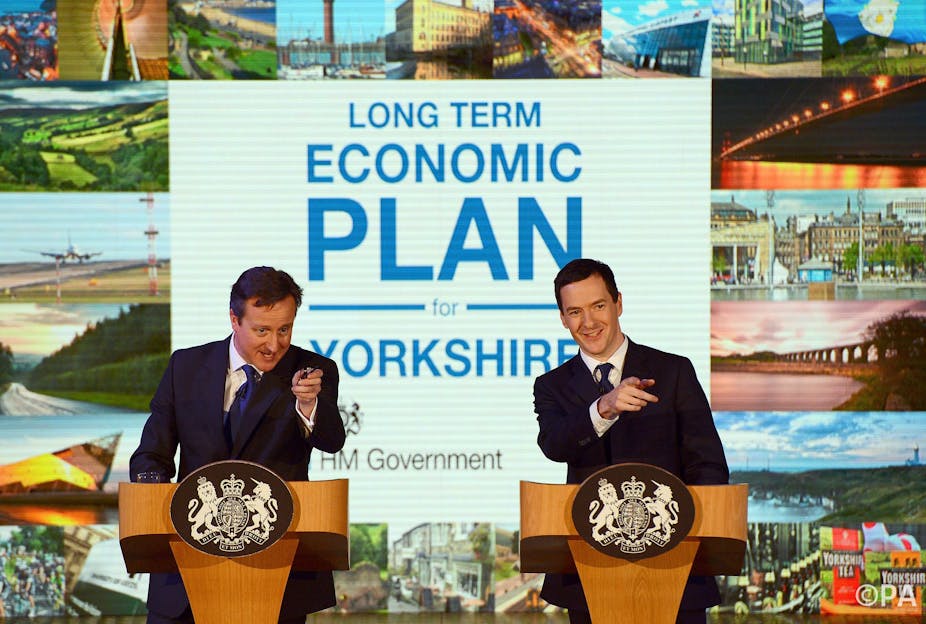Economy
William Tayler, Development Lecturer at Lancaster University
The Conservative manifesto commits the party to an additional round of austerity. This will be accomplished with a further £30 billion of spending cuts with the aim of generating a balanced budget by 2017-2018 and a surplus in 2018-2019.
The party’s view is that a balanced budget should be reached quickly with an emphasis on cuts to public spending. As a result they are proposing the most rapid deficit reduction programme of the three main parties. While their approach appears to provide a simple “quick fix” that will restore public finances, the least painful way of reducing budget deficits and public debt is slowly, using policies which promote (or at least limit the fall in) economic growth.
Growth, in turn, reduces the deficit by increasing tax revenues and reducing welfare spending, while lowering the current stock of debt as a proportion of GDP. Faster deficit reduction, through rapid austerity measures, has the opposite effect since it reduces the income of consumers, who then spend less. This then further reduces economic growth and limits its effectiveness as a deficit and debt reducing strategy. Given the low cost of government borrowing and the current limitations of monetary policy to stimulate aggregate demand, an easing of the pace of austerity may be preferable.
Behind the rose-tint
The party boasts to have successfully halved the inherited budget deficit and restored confidence in the UK economy. They point to the 1,000 jobs a day being created and forecasts of seeing a fall in debt to GDP this year. While employment levels have shown significant improvement, other measures of economic performance paint a less rosy picture of the state of the UK economy than the party’s opening comments in their manifesto.
For example, the considerably persistent fall in real wages during the last parliament and productivity per hour worked remaining at around 16% lower than pre-crisis levels. Admittedly, a large proportion of these falls are a hangover from the financial crisis and the prolonged recession in the eurozone. But the Office of Budget Responsibility estimate that austerity reduced GDP by 2% between 2011 and 2013.
With wages and productivity low, the manifesto’s claims to support policies “that grow the economy as a whole, generating new jobs and higher wages for everybody” are welcome. Elsewhere, they propose an agenda to build a “northern powerhouse”, alongside improvements in both transport and communication infrastructure. If implemented these policies will have positive multiplier effects and generate improvements in private sector productivity and growth to the poorest areas of the country which have suffered the most from austerity.
But the magnitude of this investment is severely limited by the planned austerity measures, which according to the 2014 autumn statement would leave spending at just 1.2% of GDP by 2017-2018. Unlike the other main parties, this would not allow room for the government to borrow for additional public investment. This leaves us questioning the Conservatives’ ability to grow the economy with their commitment to austerity and balancing the budget.
Finally, the Conservatives are committed to an EU in-out referendum. Naturally this increases the possibility of an EU exit for the UK. Risking the trade links and positive impact of EU migration poses a threat to economic growth, which would either increase the required level of austerity or hamper their ability to reduce the deficit.
Banking and finance
Rosa Lastra, Professor of International Financial and Monetary Law at Queen Mary University of London
Rosa Lastra, Professor of International Financial and Monetary Law at Queen Mary University of London
The Conservative Party manifesto promises to ensure that banks help secure our recovery, and back business to create jobs and growth. While this is, of course, a welcome commitment, the truth is that banks face external and internal pressures, with higher capital requirements and other rules in the aftermath of the financial crisis, as well as the challenges of the so-called shadow banks.
Like Labour, the Conservative Party promises to support the growth of credit unions, and to help new challenger banks to enter the market. Competition is certainly needed in the banking sector to improve the access to credit for households and SMEs. And the legal structure of credit unions may facilitate serving the needs of communities tied together by shared local, regional or professional interests.
The Conservative party pledges to continue to provide access to credit via the British Business Bank, and to back the financial technology revolution. Under the Help to Grow initiative, 500 firms each year will receive financial support through the new British Business Bank, both through the form of loans and match funding with private investment.
The “technology revolution” – as the example of Silicon Valley in the US proves – can be a source of innovation and growth. The American experience also shows that venture capital is needed to support investment into start-ups. So the Help to Grow initiative should be accompanied by other private sources of capital.
The manifesto points out how the government capped payday lenders. Again, the growth of the latter was in direct response of the need to access credits by clients that found it difficult because of their credit history to access the regular banking loans. The development of peer-to-peer lending platforms in response to the credit needs of individuals and SMEs is another example of the credit squeeze felt by many.
The Conservative manifesto also promises to continue the Funding for Lending scheme into 2016 to boost bank lending to households and companies. Clearly the party is concerned about the need to facilitate the access to credit (coming from banks and other sources) for individuals and SMEs.
The Conversation’s Manifesto Check deploys academic expertise to scrutinise the parties’ plans.

